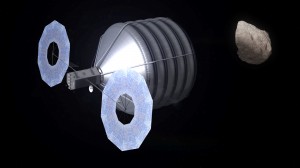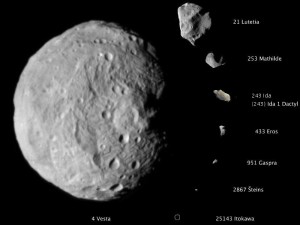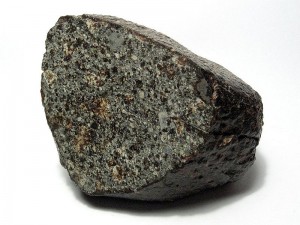Asteroid Retrieval
It has been proposed that NASA go out, grab an asteroid, and bring the asteroid to Earth. It would be placed into high lunar orbit (not directly in Earth orbit). Once there, astronauts can go out to visit it.
This would demonstrate key technologies like the solar electric propulsion and the ability to move asteroids, which could be important someday if we see the big one heading toward the Earth. The relocated asteroid will become a destination for astronauts in the new Orion space capsule. Such a trip will be a test of our ability to go farther than we ever have before without going all the way to Mars. It would be much healthier than going all the way out to the asteroid in its original orbit around the sun, which would give the crew an unacceptably huge dose of cosmic radiation. (That’s a problem we still need to solve.)
The proposed mission will also give us the best opportunity EVER to study an asteroid, a fundamental building block of planets and an historical record of our solar system. So you can count on really awesome science coming from it! And as if that weren’t enough, it will give us the opportunity to mine a real asteroid in weightlessness, demonstrating our ability to gather space resource that enable even more ambitious activities in space.
There are many, many kinds of rocks in space, so before we bring an asteroid to Earth we need to think which kind will accomplish all these purposes. The next few posts will cover some important asteroid characteristics to consider.
An Asteroid’s Size
One of the most important features is the asteroid’s size. It would be absolutely fantastic if we could bring back a huge asteroid, a dwarf planet like Ceres, one that has enough gravity for Bruce Willis and a team of oil drillers to drive around on their asteroid buggy shooting its Gatling gun. But that would require too huge a spacecraft to haul back to the Earth, too much fuel, and too much money. Furthermore, it would be a bit dangerous. What happens if we make a mistake while hauling it back and accidentally hit the Earth instead? Larger than 25 to 30 meters, a portion of the asteroid could survive entry through the Earth’s atmosphere and hit the surface. Pow! That could be really bad. But smaller than 10 meters an errant asteroid will completely burn up, causing nothing more than a brilliant display of light and color in the sky. We are considering an asteroid in the range of 7 – 10 meters in diameter if we can find a good one. That’s plenty small enough for safety.
By the way, if we bring back a rock smaller than 1 meter, then technically it’s not an asteroid; it’s a meteoroid. Visiting such a rock would not fulfill the President’s direction to visit an asteroid. We have to draw the lines somewhere. Before 2010, a space rock had to be bigger than 10 meters to be considered an asteroid. After a bunch of really big space rocks smaller than 10 meters were discovered, scientists decided they should be called asteroids, so the limit was moved down to 1 meter to be more inclusive. This was four years after Pluto had been kicked out from being a planet, so maybe they were feeling guilty and tried to make up for it. Anyhow, a 7 meter space rock now counts as an asteroid, and it’s small enough to bring to Earth economically so astronauts can visit it without exposure to too much cosmic radiation.
One last consideration about the size: can we get enough resources from a 7 meter asteroid to really do anything with it? Well, some asteroids are as much as 22% water by mass (in the form of hydrated minerals). That means a 7 meter asteroid could yield up to 83 metric tons of water! That’s enough propellant to send a Human-class, 52 ton spacecraft from low Earth orbit to Mars (Δv=4.3 km/s). To launch that much propellant from Earth up to low Earth orbit would cost more than a third of a billion dollars on the least expensive launcher available today! That’s not enough savings to recoup the development cost of the asteroid retrieval mission, but it’s a good start toward setting up an in-space capability that can pay back a million-fold or even a billion-fold in the longer run. And that doesn’t account for the value of the other materials in the asteroid, such as metals for 3D printing of spaceships. So I’d say a 7 meter asteroid is big enough for a first mission! It gives us a great opportunity to develop and test some very important technologies.
Next topic: what type of trajectory the asteroid should be on when we go out to get it?




Excellent writeup.
Is it possible for someone knowledgeable to predict how long it will take before something like this (bringing an asteroid of significant size to earth) will be achievable? Are we talking years, decades, a century? Thanks
Hi Mariah! The idea is to rendezvous with the asteroid and capture it in 2019, then start the journey to Earth orbit (high lunar orbit, actually), and have astronauts visit it in 2021. So engineering of the hardware will need to begin right away. It is a very near-term mission. Thanks for the great question!
Dr. Metzger, are you aware of anyone actually heating up a meteorite and evolving water out of it? I can’t find a reference to that effect. Sure, there have been plenty of mineralogical and chemical analyses of carbonaceous chondrites that document the presence of hydrated minerals. And yes, if you stick chunk of portland cement into a microwave, it’ll start steaming. But I’m afraid that if you heat up the clay minerals of an asteroid in the presence of all the other junk that makes up the rock, all you’ll get is CO, CO2, FeO, NiO, SO2, etc., but no water. I hope I am wrong about that!
Hi Warren! I emailed your question to Stephen Covey, an asteroid miner at Deep Space Industries (www.DeepSpaceIndustries.com). He gave me this to pass on to you:
“A number of researchers have thoroughly analyzed the volatiles in a variety of meteorites, especially carbonaceous chondrites.
“For the most part, they have gradually heated the specimens while using mass spectrometers to identify the emitted gases. Water vapor is released in several distinct steps, consistent with the chemistry that bound it to the minerals of the meteorite. But other gases were identified, also, including CO2, HCN (cyanide), and quite a few complex carbohydrates. Of course, when you heat a carbonaceous chondrite sufficiently, the carbon compounds react with the metal oxides (largely magnetite), reducing the metal and releasing more CO2 (and a little more water, as the kerogens that haven’t already vaporized do contain some hydrogen).”
I hope that helps!
…a possible solution… INCREASING ITS SPEED, gives it a shove, TOWARDS A SIDE IF THERE ARE LITTLE TIME, to what speed gives it thrust towards a side for deflecting it?…speed = space/time…so if want that it passing “close shaving” to 1,000 kms from Earth = 1 million mts, and having approx. 11 days = 1 million seconds, the correction speed will be of: 6,000 kms approx. Earth radius + 1,000 kms = 7,000 kms; 7 million mts/1 million seconds = 7 mts/second (25 kms/hour). If it increases forwards speed, it climbs to a higher orbit, and vice versa: radius = (mass*speed²)/force (centripetal) from Sun gravitational attraction.